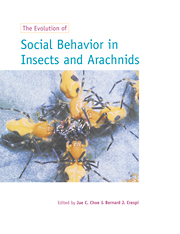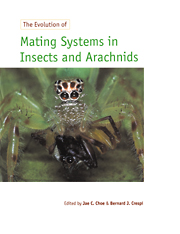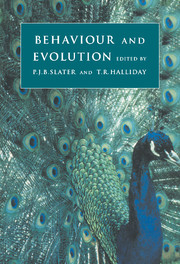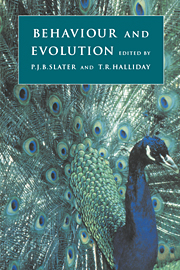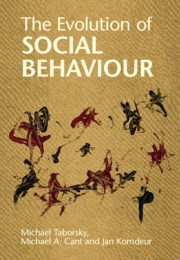The Evolution of Social Behaviour in Insects and Arachnids
Social insects and arachnids exhibit forms of complex behavior that involve cooperation in building a nest, defending against attackers or rearing offspring. This book is a comprehensive, up-to-date guide to sociality and its evolution in a wide range of taxa. In it, leading researchers review the extent of sociality in different insect and arachnid groups, analyze the genetic, ecological and demographic causes of sociality from a comparative perspective, and suggest ways in which the field can be better understood. The book contains fascinating accounts of the social lives of many different insects and arachnids, as well as tests of current theories of the evolution of social behavior. The Evolution of Social Behaviour in Insects and Arachnids provides essential reading and insight for students and researchers interested in social behavior, behavioral ecology, entomology, and arachnology.
- Evolution of cooperation and social behaviour very hot topic in behavioural ecology, evolutionary biology and animal behaviour
- Comprehensive and up-to-date guide to sociality in an extremely wide range of insects and arachnids (spiders, mites and scorpions)
- Star-studded and internationally renowned contributors
Reviews & endorsements
"This book is accessible reading for any evolutionary or behavioral biologist. If the Embioptera, Thysanoptera, or Passalidae are unfamiliar taxa to you, so much the better; the authors do an excellent job of placing these taxa in systematic, evolutionary, and ecological contexts, and your appreciation of the social diversity of arthropods will be greatly enhanced. The issues raised by Choe, Crespi, and the authors of the chapters presage continued exciting developments over the next few years in our understanding of social evolution." Michael D. Breed, BioScience
Product details
March 2011Adobe eBook Reader
9780511823015
0 pages
0kg
88 b/w illus. 97 tables
This ISBN is for an eBook version which is distributed on our behalf by a third party.
Table of Contents
- Introduction
- 1. Are behavioural classifications blinders to natural variation?
- 2. Life beneath silk walls: a review of the primitively social Embiidina
- 3. Post-ovulation parental investment and parental care in cockroaches
- 4. The spectrum of eusociality in termites
- 5. Maternal care in the Hemiptera: ancestry, alternatives and current adaptive value
- 6. Evolution of parental care in the giant water bugs (Heteroptera: Bolostomatidae)
- 7. The evolution of sociality in aphids: a clone's eye view
- 8. Ecology and evolution of social behaviour among Australian gall thrips
- 9. Interactions among males, females and offspring in bark and ambrosia beetles: the significance of living in holes for the evolution of social behaviour
- 10. Biparental care and social evolution in burying beetles: lessons from the larder
- 11. Subsocial behaviour in Scarabaeiinae
- 12. Evolution of social behaviour in Passalidae (Coleoptera)
- 13. The evolution of social behaviour in the Augochlorine bees (Hymenoptera: Halicitidae) based on a phylogenetic analysis of the data
- 14. Demography and sociality in halictine bees (Hymenoptera: Halictidae)
- 15. Behavioural environments of sweat bees (Halictinae) and variability in social organization
- 16. Intrinsic and extrinsic factors associated with social evolution in allodapine bees
- 17. Cooperative breeding in wasps and vertebrates: the role of ecological constraints
- 18. Morphologically 'primitive' ants: comparative review of social characters, and the importance of queen-worker dimorphism
- 19. Social conflict and cooperation among founding queens in ants (Hymenoptera: Formicidae)
- 20. Social evolution in the lepidoptera: ecological context and communication in larval societies
- 21. Sociality and kin selection in Acari
- 22. Colonial web-building spiders: balancing the costs and benefits of group living
- 23. Causes and consequences of cooperation and permanent-sociality in spiders
- 24. Evolution and explanation of social systems
- Index.

